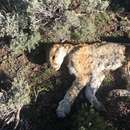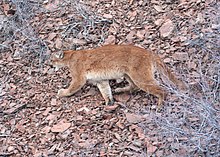en
names in breadcrumbs


Perception Channels: tactile ; chemical
The Florida panther has been listed as an endangered species under the Endangered Species Act since its passage in 1973. The Florida panther is in grave danger of becoming extinct. They have an estimated population of 20-50 animals. They are relegated to small habitat pockets, and the only areas they can be predictably found are in Everglades National Park and Big Cypress National Preserve. Most panther populations were eliminated before 1900 by settlers who hunted them because they killed livestock as well as out of fear. Other historical factors leading to the panther's decline were habitat loss due to human encroachment and a subsequent reduction in prey species. Added threats today include low population numbers resulting in little genetic variability and disease and parasites. Conservation and recovery efforts are headed by the Florida Panther Record Clearinghouse, established in 1976 by the Florida Game and Fresh Water Fish Commission.
US Federal List: endangered
CITES: appendix i
Florida panthers are predatory carnivores, with white-tailed deer being the most important prey species. Other significant prey species include rabbit, raccoon, wild hog, armadillo, and birds. They forage using stalk and pounce methods common among cats. Prey is approached slowly and attacked with short, high speed bursts. Large prey like deer are killed by biting the spinal cord on the top of the neck where the neck and head join. Kills are dragged to a concealed place for the panther to feed. The forequarters of the carcass are eaten first, and the rest is buried with grass and fed upon later. Florida panthers will spend approximately three to four days at a kill site.
Primary Diet: carnivore (Eats terrestrial vertebrates)
Southeastern United States. The Florida panther's range is limited to small pockets in southern Florida. It originally ranged from eastern Texas through Arkansas, Louisiana, Mississippi, Alabama, Georgia, Florida, and parts of Tennessee and South Carolina
Biogeographic Regions: nearctic (Native )
Florida panthers are most often found in mixed swamp forests and hammock forests. Habitats can vary over a home range, but generally are heavily vegetated. Other common habitats are slash pine-saw palmetto woodlands and oak-pine woodlands. Their daytime habitat tends to be in dense vegetation and covered wet prairies, while at night they use more open prairies and marshes. Panthers are good swimmers and can cross canals, swamps and marshes easily. They also commonly uses human paths as travel lanes and routinely cross highways.
Terrestrial Biomes: forest ; scrub forest
Weight: Males-48 to 67 kg.
Females-30 to 45 kg.
The average length of a male Florida panther is 2.13 m (7 ft.) from nose to tail. Females measure approximately 1.83 m (6 ft.) nose to tail. Puma concolor coryi has a short, stiff dark brown pelage. The mid-dorsal region is particularly rich in color, and has irregular white flecking on the head, nape, and shoulders. On the middle of the back, Florida panthers usually have a whorl of hair, or cowlick, which differs from the pattern of the rest of the hair. The limbs are long with small feet, and a right angle crook at the end of the tail. The tail crook, whorl of hair, and white flecking are not found in other subspecies of P. concolor coryi.
Range mass: 30 to 57 kg.
Other Physical Features: endothermic ; bilateral symmetry
Florida panthers are seasonal breeders, with the season starting in October and continuing through March. The majority of conceptions occur from November to March. Males reach sexual maturity at three years of age, while females become sexually mature between two and three years old. The gestation period is 90-95 days. Litters consist of between one to three kittens. Kittens become independent after one and-a-half years. As a result, females tend to breed every other year.
Key Reproductive Features: gonochoric/gonochoristic/dioecious (sexes separate); sexual
Parental Investment: altricial ; post-independence association with parents; extended period of juvenile learning
The Eastern Cougar was at one time a top of the line predator with a range stretching through northeastern United States and eastern Canada. Cougars prefer habitat with ample coverage for stalking and ambushing, along with sustainable populations of prey (Laundré, 2013). Prey consists of just about anything that can be caught, including porcupines, but the food of choice is white-tailed deer for this eastern predator. Development and expansion by humans led to an increase in contact with cougars, with the big cats getting the raw end of the deal. Conflicts with farmers, and depredation by hunters rapidly diminished cougar populations east of the Mississippi. To date, cougar signs are scarce, even non-existent in some regions. In 2011 the US Fish and Wildlife Service declared the subspecies extinct, although many cougar watch groups insist that there are hidden pockets of cougars in the remaining patches of protected wilderness.
Cougars are solitary creatures, and their territories can cover hundreds of square kilometers (Grigione et al., 2002). Today, only a fraction of the lands once inhabited by cougars is still wilderness. This reduction in population and hunting grounds for Puma concolor couguar has had far reaching effects on other species. White-tailed deer, a favorite meal of cougars, have reproduced to astounding numbers with the elimination of natural predators. They have become a nuisance, causing car accidents and heavy damage to trees and shrubs through over foraging.
By habit, cougars hunt using stealth and surprise. Their native territories are abundant in trees and rocky outcroppings, as well as heavy underbrush from which to spring ambushes. Cougars cache larger prey that they cannot finish in one meal. They will remain in the vicinity until the stash is finished. In the event of a conflict with other top predators over a kill, the cougar will generally avoid confrontation and leave, even if it was their kill (Kortello et al., 2007). A cougar’s home turf will fluctuate depending on the seasonal movements of prey populations (Grigione, et al., 2002).
Female cougars give birth to young year round, although studies have indicated that the months of July-September tend to have higher birth rates. Cubs become independent after approximately 16 months (Laundré & Hernández, 2007). Young males will often travel vast distances, likely contributing to genetic diversity amongst more stable populations. Genetically North American cougars have been shown to be very similar, to the point where some studies have suggested that native North American cougars lack subspecies differentiation (Culver, et al., 2000). North American cougars are genetically distinct from their South American counterparts, and this difference has been a useful tool in identifying whether or not a particular animal is clearly an escaped captive import, or a wild native. This particular question is a large part of the mystery surrounding the current existence of eastern cougars. There is evidence of cougars inhabiting the eastern regions of the US and Canada, but whether they are natives, or immigrants, or escaped captives remains a topic of hot debate.
The North American cougar (Puma concolor couguar) is a cougar subspecies in North America. It is the biggest cat in North America, with North American jaguars being fairly small.[4][5] It was once common in eastern North America, and is still prevalent in the western half of the continent. This subspecies includes populations in western Canada, the western United States, Florida, Mexico and Central America, and possibly South America northwest of the Andes Mountains.[6] It thus includes the extirpated eastern cougar and extant Florida panther populations.
As of 2017, P. c. cougar was recognised as being valid by the Cat Classification Taskforce of the Cat Specialist Group. P. c. costaricensis had been regarded as a subspecies in Central America.[6][7]
The North American cougar has a solid tan-colored coat without spots and weighs 25–80 kg (55–176 pounds).[8] Females average 50 kg (110 lb), about the same as a jaguar in the Chamela-Cuixmala Biosphere Reserve on the Mexican Pacific coast.[5]
The North American cougar lives in various places and habitats.[8] Several populations still exist and are thriving in the Western United States, Southern Florida, and Western Canada, but the North American cougar was once commonly found in eastern portions of the United States. It was believed to be extirpated there in the early 1900s. In Michigan, it was thought to have been killed off and extinct in the early 1900s. Today there is evidence to support that cougars could be on the rise in Mexico and could have a substantial population in years to come. Some mainstream scientists believe that small relict populations may exist (around 50 individuals), especially in the Appalachian Mountains and eastern Canada.[9] Recent scientific findings in hair traps in Fundy National Park in New Brunswick have confirmed the existence of at least three cougars in New Brunswick.[9] The Ontario Puma Foundation estimates that there are currently 850 cougars in Ontario.
The Quebec wildlife services also considers cougars to be present in the province as a threatened species after multiple DNA tests confirmed cougar hair in lynx mating sites.[10] The only unequivocally known eastern population is the critically endangered Florida panther. There have been unconfirmed sightings in Elliotsville Plantation, Maine (north of Monson) and as early as 1997 in New Hampshire.[11]
Reported sightings of cougars in the eastern United States continue today, despite their status as extirpated.
While the origins of these animals are unknown, some cougar experts believe some are captive animals that have been released or escaped.[20]

The North American cougar usually hunts at night and sometimes travels long distances in search of food. Its average litter size is three cubs.[8] It is fast, and can maneuver quite easily and skillfully.[7] Depending on the abundance of prey such as deer, it shares the same prey as the jaguar in Central or North America.[21] Other sympatric predators include the grizzly bear and American black bears.[22] Cougars are known to prey on bear cubs.[23] Cougars in the Great Basin have been recorded to prey on feral horses,[24] as well as feral donkeys in the Sonoran and Mojave Deserts.[25]
Rivalry between the cougar and grizzly bear was a popular topic in North America. Fights between them were staged, and those in the wilderness were recorded by people, including native peoples.[26]

Even though conservation efforts of the cougar have decreased against the "more appealing" jaguar, it is hunted less frequently because it has no spots, and is thus less desirable to hunters.[7]
In Oregon, a healthy population of 5,000 was reported in 2006, exceeding a target of 3,000.[27] California has actively sought to protect the cat and has an estimated population of 4,000 to 6,000.[28] With the increase of human development and infrastructure growth in California, the cougar populations in the state are becoming more isolated from one another.[29]
A 2012 study using 18 motion-sensitive cameras in Río Los Cipreses National Reserve counted a population of two males and two females (one of them with at least two cubs) in an area of 600 km2 (0.63 cougars per 100 km2).[30] The Bay Area Puma Project aims to obtain information on cougar populations in the San Francisco Bay area and the animals' interactions with habitat, prey, humans, and residential communities.[31] A study on wildlife ecologists showed that urban cougar populations exist around the Los Angeles metropolitan area, with individuals of these populations having the smallest home ranges recorded for any cougars studied, and being primarily nocturnal and not crepuscular (most likely adaptations to avoid humans in high-density areas).[32]
The North American cougar (Puma concolor couguar) is a cougar subspecies in North America. It is the biggest cat in North America, with North American jaguars being fairly small. It was once common in eastern North America, and is still prevalent in the western half of the continent. This subspecies includes populations in western Canada, the western United States, Florida, Mexico and Central America, and possibly South America northwest of the Andes Mountains. It thus includes the extirpated eastern cougar and extant Florida panther populations.